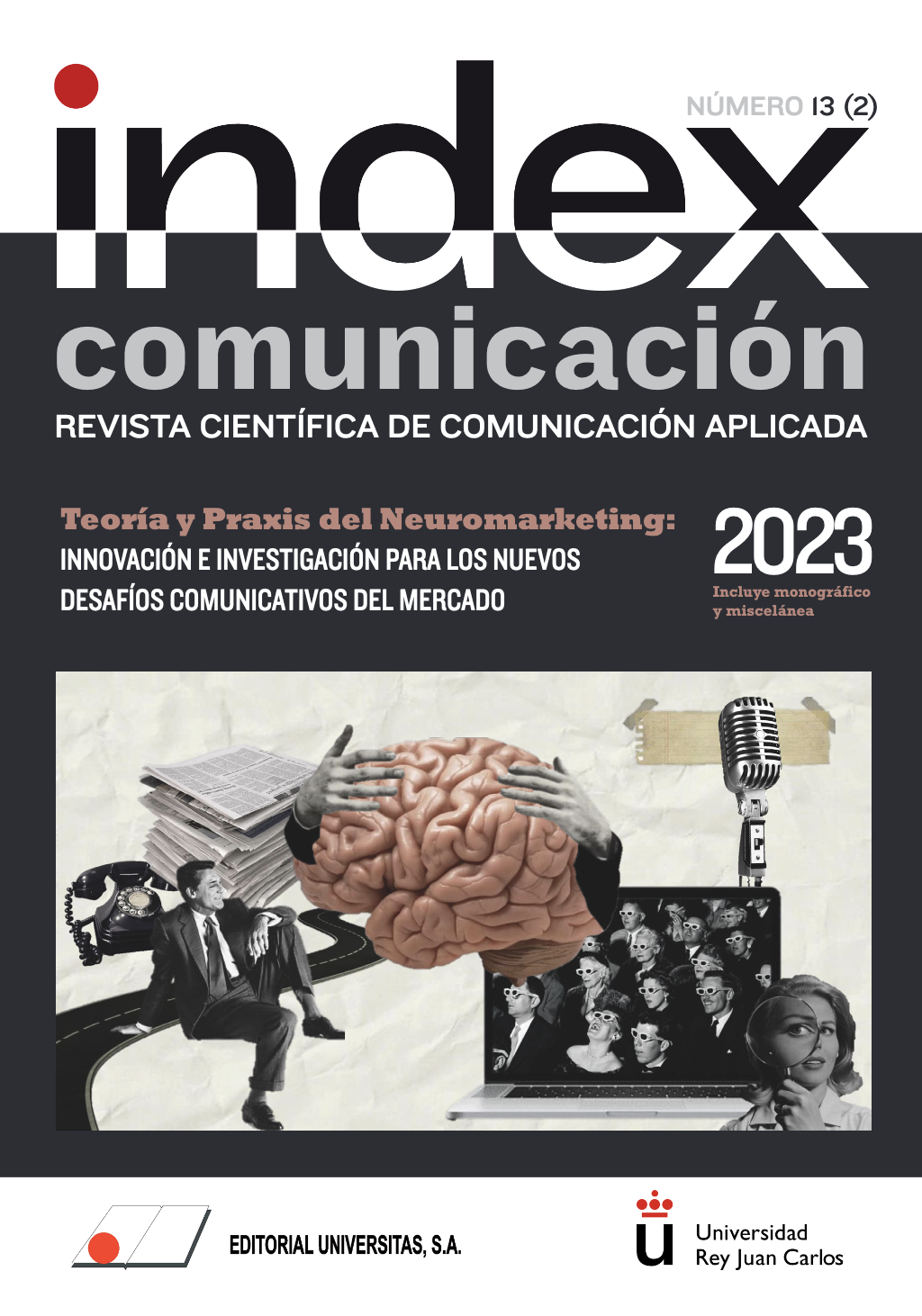Un estudio exploratorio con neurociencia. Impacto del género en la respuesta a las campañas sociales en jóvenes
DOI:
https://doi.org/10.33732/ixc/13/02UnestuPalabras clave:
campañas sociales, marketing social, electroencefalograma, respuesta electrodérmica, neuromarketing, género, neurocienciaResumen
El objetivo de este estudio es identificar el posible impacto diferencial entre hombres y mujeres de una campaña de concienciación sanitaria frente al COVID-19. Para ello, se han utilizado herramientas neurofisiológicas que permiten analizar las respuestas vinculadas a la activación, el engagement, la atención, la memorización y la valencia. Además, se incorpora una encuesta previa y posterior al visionado de la campaña mediante la cual se evalúan las emociones provocadas, así como la disposición a cumplir las normas sanitarias. Se diseñó un experimento en el que 45 participantes entre 19 y 24 años se expusieron a una campaña social sobre el COVID-19 para concienciar sobre el cumplimiento de la normativa frente a la pandemia. Se utilizaron dos técnicas neurofisiológicas: la conductancia de la piel y el electroencefalograma; los dispositivos fueron proporcionados por BitBrain Technologies. Los resultados indicaron que la campaña expuesta generó mayor activación y engagement en los hombres. En el caso de las mujeres se obtuvieron puntuaciones más elevadas en la atención, memorización y valencia. Estos datos indican que las campañas sociales impactan de modo diferente en hombres y mujeres. Este trabajo realiza una primera aportación exploratoria con herramientas neurofisiológicas en el análisis del impacto diferencial de las campañas publicitarias sociales en función del género.
Métricas
Citas
BAGOZZI, R. P., GOPINATH, M. y NYER, P. U. (1999). The role of emotions in marketing. Journal of the Academy of Marketing Science, 27(2), 184-206. doi.org/10.1177/0092070399272005
BARGH, J. A. y CHARTRAND, T. L. (1999). The unbearable automaticity of being. American Psychologist, 54(7), 462-479.
doi.org/10.1037/0003-066X.54.7.462
BARGH, J. A., SCHWADER, K. L., HAILEY, S. E., DYER, R. L. y BOOTHBY, E. J. (2012). Automaticity in social-cognitive processes. Trends in Cognitive Sciences, 16(12), 593-605. doi.org/10.1016/j.tics.2012.10.002
BAZZANI, A., RAVAIOLI, S., TRIESTE, L., FARAGUNA, U. y TURCHETTI, G. (2020). Is EEG suitable for marketing research? A systematic review. Frontiers in Neuroscience, 14, 594566. doi.org/10.3389/fnins.2020.594566
BETTIGA, D., LAMBERTI, L. y NOCI, G. (2017). Do mind and body agree? Unconscious versus conscious arousal in product attitude formation. Journal of Business Research, 75, 108-117. doi.org/10.1016/j.jbusres.2017.02.008
BORAWSKA, A., OLEKSY, T. y MAISON, D. (2020). Do negative emotions in social advertising really work? Confrontation of classic vs. EEG reaction toward advertising that promotes safe driving. PLoS ONE, 15(5), 1-20. doi.org/10.1371/journal.pone.0233036
BRAVO, M. P. C. y RODRÍGUEZ, I. Q. (2020). Respuesta de los/as adolescentes hacia una campaña de realidad virtual sobre violencia de género. Prisma Social: revista de investigación social, (30), 186-206.
BRAUN, K. A., GAETH, G. J. y LEVIN, I. P. (1997). Framing effects with differential impact: The role of attribute salience. Advances in Consumer Research, 24(1), 405-411.
CARFORA, V. y CATELLANI, P. (2021). The Effect of Persuasive Messages in Promoting Home-Based Physical Activity During COVID-19 Pandemic. Frontiers in Psychology, 12(April), 1-14. doi.org/10.3389/fpsyg.2021.644050
CIORCIARI, J. (2012). Bioelectrical signals: The electroencephalogram. In A. WOOD (ed.), Physiology, biophysics, and biomedical engineering. Taylor & Francis Inc.
DARLEY, W. K. y SMITH, R. E. (1995). Gender differences in information processing strategies: An empirical test of the selectivity model in advertising response. Journal of Advertising, 24(1), 41-56. doi.org/10.1080/00913367.1995.10673467
DEL MORAL PÉREZ, M. E., BELLVER MORENO, M. C., LÓPEZ-BOUZAS, N. & CASTAÑEDA FERNÁNDEZ, J. (2023). Pro-environmental Advertising Strategies of Greatest Impact Among College Audiences. index.Comunicación, 13(1), 223-246. doi.org/10.33732/ixc/13/01Proenv
DEL MORAL-PÉREZ, M. E., BELLVER-MORENO, M. C., GUZMÁN-DUQUE, A. P. y LÓPEZ-BOUZAS, N. (2021). Concienciación juvenil frente al COVID-19 en España y Latinoamérica: análisis de spots en YouTube. Revista Latina de Comunicación Social, (79), 23-49. doi.org/10.4185/RLCS-2021-1510
DUHACHEK, A., AGRAWAL, N. y HAN, D. (2012). Guilt versus shame: Coping, fluency, and framing in the effectiveness of responsible drinking messages. Journal of Marketing Research, 49(6), 928-941. doi.org/10.1509/jmr.10.0244
DU PLESSIS, E., LEIGHTON, J. & DALVIT, S. (2011). The branded mind: what neuroscience really tells us about the puzzle of the brain and the brand. Int. J. Advert. 30, 723-725. doi.org/10.2501/IJA-30-4-723-725
FRADE, A. T., FERNÁNDEZ, M. R. y GUERRA, E. M. (2017). Diferencias de género en el consumo audiovisual: un experimento de neurociencia sobre spots de televisión. Vivat Academia. Revista de Comunicación, (141), 39-54. doi.org/10.15178/va.2017.141.39-54
GARCÍA-MADARIAGA, J., LÓPEZ, M. F. B., BURGOS, I. M. y VIRTO, N. R. (2019). Do isolated packaging variables influence consumers' attention and preferences? Physiology & Behavior, 200, 96-103. doi.org/10.1016/j.physbeh.2018.04.030
GOUNTAS, J., GOUNTAS, S., CIORCIARI, J. y SHARMA, P. (2019). Looking beyond traditional measures of advertising impact: Using neuroscientific methods to evaluate social marketing messages. Journal of Business Research, 105(July), 121-135. doi.org/10.1016/j.jbusres.2019.07.011
GREEN, M. C. y BROCK, T. C. (2000). The role of transportation in the persuasiveness of public narratives. Journal of Personality and Social Psychology, 79(5), 701-721. doi.org/10.1037/0022-3514.79.5.701
GUENTHER, L., GAERTNER, M. y ZEITZ, J. (2021). Framing as a concept for health communication: A systematic review. Health Communication, 36(7), 891-899. doi.org/10.1080/10410236.2020.1723048
HAKIM, A., KLORFELD, S., SELA, T., FRIEDMAN, D., SHABAT-SIMON, M. y LEVY, D. J. (2021). Machines learn neuromarketing: Improving preference prediction from self-reports using multiple EEG measures and machine learning. International Journal of Research in Marketing, 38(3), 770-791. doi.org/10.1016/j.ijresmar.2020.10.005
HAMELIN, N., THAICHON, P., ABRAHAM, C., DRIVER, N., LIPSCOMBE, J. y PILLAI, J. (2020). Storytelling, the scale of persuasion and retention: A neuromarketing approach. Journal of Retailing and Consumer Services, 55, 102099. doi.org/10.1016/j.jretconser.2020.102099
HARRIS, J. M., CIORCIARI, J. y GOUNTAS, J. (2018). Consumer neuroscience for marketing researchers. Journal of consumer behaviour, 17(3), 239-252.
HASSELDINE, J. y HITE, P. A. (2003). Framing, gender y tax compliance. Journal of Economic Psychology, 24(4), 517-533.
doi.org/10.1016/S0167-4870(02)00209-X
IGARTUA, J. J. (2011). Mejor convencer entreteniendo: comunicación para la salud y persuasión narrativa. Revista de Comunicación y Salud: RCyS, 1(1), 69-83.
KIM, H. S., BIGMAN, C. A., LEADER, A. E., LERMAN, C. y CAPPELLA, J. N. (2012). Narrative health communication y behavior change: The influence of exemplars in the news on intention to quit smoking. Journal of Communication, 62(3), 473-492.
doi.org/10.1111/j.1460-2466.2012.01644.x
KUBACKI, K., RUNDLE-THIELE, S., PANG, B. y BUYUCEK, N. (2015). Minimizing alcohol harm: A systematic social marketing review (2000-2014). Journal of Business Research, 68(10), 2214–2222. doi.org/10.1016/j.jbusres.2015.03.023
LEE, E. J. (2016). Empathy can increase customer equity related to pro-social brands. Journal of Business Research, 69(9), 3748–3754. doi.org/10.1016/j.jbusres.2015.05.018
LIM, W. M. (2018). Demystifying neuromarketing. Journal of Business Research, 91, 205-220. doi.org/10.1016/j.jbusres.2018.05.036
MAXIMILIANO, D. (2022). Characterisation of official spokespersons in humanitarian crisis situations: the case of COVID-19 in Argentina and Spain. aDResearch ESIC International Journal of Communication Research, 27(27), e201. doi.org/10.7263/adresic-27-201
MICU, A. C. y PLUMMER, J. T. (2010). Measurable emotions: How television ads really work: Patterns of reactions to commercials can demonstrate advertising effectiveness. Journal of Advertising Research, 50(2), 137-153. doi.org/10.2501/S0021849910091300
MURALIDHARAN, S. y SHEEHAN, K. (2018). The role of guilt in influencing sustainable pro-environmental behaviors among shoppers: Differences in response by gender to messaging about Engly's plastic-bag levy. Journal of Advertising Research, 58(3), 349-362. doi.org/10.2501/JAR-2017-029
O’KEEFE, D. J. y JENSEN, J. D. (2007). The relative persuasiveness of gain-framed and loss-framed messages for encouraging disease prevention behaviors: A meta-analytic review. Journal of Health Communication, 12(7), 623-644. doi.org/10.1080/10810730701615198
PLASSMANN, H., VENKATRAMAN, V., HUETTEL, S. y YOON, C. (2015). Consumer neuroscience: applications, challenges, and possible solutions. Journal of Marketing Research, 52(4), 427-435. doi.org/10.1509%2Fjmr.14.0048
PIÑEIRO-NAVAL, V. y MANGANA, R. (2018). Teoría del encuadre: Panorámica conceptual y estado del arte en el contexto hispano. Estudios sobre el mensaje periodístico, 24(2), 1541. doi.org/10.5209/ESMP.62233
POELS, K. y DEWITTE, S. (2006). How to Capture the Heart? Reviewing 20 Years of Emotion Measurement in Advertising. Journal of Advertising Research, 46(1), 18-37. doi.org/10.2501/S0021849906060041
POELS, K. y DEWITTE, S. (2019). The role of emotions in advertising: a call to action. Journal of Advertising, 48(1), 81-90. doi.org/10.1080/00913367.2019.1579688
POTTER, R. F. & BOLLS, P. (2012). Psychophysiological Measurement and Meaning: Cognitive and Emotional Processing of Media. Routledge.
POZHARLIEV, R., VERBEKE, W. J. y BAGOZZI, R. P. (2017). Social consumer neuroscience: Neurophysiological measures of advertising effectiveness in a social context. Journal of Advertising, 46(3), 351-362. doi.org/10.1080/00913367.2017.1343162
PUTREVU, S. (2010). An examination of consumer responses toward attribute-and goal-framed messages. Journal of Advertising, 39(3), 5-24. doi.org/10.2753/JOA0091-3367390301
ROTHMAN, A. J. y SALOVEY, P. (1997). Shaping perceptions to motivate healthy behavior: The role of message framing. Psychological Bulletin, 121, 3-19.
SCHEARZ, U., HOFFMANN, S. y KATHARINA, H. (2015). Do men and women laugh about different types of humor? A comparison of satire, sentimental comedy, and comic wit in print ads. Journal of Current Issues y Research in Advertising, 36(1), 70-87. doi.org/10.1080/10641734.2014.912599
SEPTIANTO, F., YE, S. y NORTHEY, G. (2021). The effectiveness of advertising images in promoting experiential offerings: An emotional response approach. Journal of Business Research, 122, 344-352. doi.org/10.1016/j.jbusres.2020.09.015
SOUTTER, A. R. & BOAG, S. (2019). Environmental advertising: The effect of imagery on pro-environmental attitudes and pro-environmental behaviour / Publicidad medioambiental: el efecto de las imágenes sobre las actitudes proambientales y el comportamiento proambiental. PsyEcology, 10(1), 88-126. doi.org/10.1080/21711976.2018.1550238
SWANI, K., WEINBERGER, M. G. y GULAS, C. S. (2013). The impact of violent humor on advertising success: A gender perspective. Journal of Advertising, 42(4), 308-319. doi.org/10.1080/00913367.2013.795121
TOLL, B. A., SALOVEY, P., O'MALLEY, S. S., MAZURE, C. M., LATIMER, A. & MCKEE, S. A. (2008). Message framing for smoking cessation: The interaction of risk perceptions and gender. Nicotine & tobacco research, 10(1), 195-200. doi.org/10.1080/14622200701767803
TOMA, F. M. y MIYAKOSHI, M. (2021). Left Frontal EEG Power Responds to Stock Price Changes in a Simulated Asset Bubble Market. Brain Sciences, 11(6), 670. doi.org/10.3390/brainsci11060670
TSICHLA, E., VOUTSA, M. C., MARGARITI, K. y HATZITHOMAS, L. (2021). Gender Responses to Emotional Appeals in Advertising: Comparing Self-Reports and Facial Expressions. In Advances in Advertising Research (Vol. XI) (pp. 241-253). Springer Gabler, Wiesbaden.
doi.org/10.1007/978-3-658-32201-4_17
VENKATRAMAN, V., DIMOKA, A., PAVLOU, P. A., VO, K., HAMPTON, W., BOLLINGER, B., ET AL. (2015). Predicting advertising success beyond traditional measures: new insights from neurophysiological methods and market response modeling. J. Mark. Res. 52, 436-452. doi.org/10.1509/jmr.13.0593
WILSON, R. T., LOHMEIER, J. H., LUSTICK, D. S. y CHEN, R. F. (2020). Using transit advertising to improve public engagement with social issues. International Journal of Advertising, 0(0), 1-27. doi.org/10.1080/02650487.2020.1807230
WOLIN, L. (2003). Gender issues in advertising – an oversight synthesis of research 1970–2002. Journal of Advertising Research, 43(1), 111-129. doi.org/10.1017/S0021849903030125
YOON, H. J., LA FERLE, C. y EDWARDS, S. M. (2017). Norm effects on gender in social marketing advertising campaigns promoting savings behavior. Journal of Current Issues y Research in Advertising, 38(1), 1. doi.org/10.1080/10641734.2016.1233151
ZHANG, J., YUN, J. H. y LEE, E. J. (2021). Brain buzz for Facebook? Neural indicators of SNS content engagement. Journal of Business Research, 130, 444-452. doi.org/10.1016/j.jbusres.2020.01.029
Publicado
Cómo citar
Número
Sección
Licencia
Derechos de autor 2023 Natividad Crespo Tejero, Susana Fernandez Lores, Ruth Fernández Hernández (Autor/a)

Esta obra está bajo una licencia internacional Creative Commons Atribución-NoComercial 4.0.
Los autores que publican en esta revista están de acuerdo con los siguientes términos:
Los autores conservan los derechos de autor y garantizan a la revista el derecho de ser la primera publicación del trabajo al igual que licenciado bajo una Licencia Creative Commons Atribución-NoComercial 4.0 Internacional que permite a otros compartir el trabajo con un reconocimiento de la autoría del trabajo y la publicación inicial en esta revista, sin finalidad comercial.
Los autores pueden establecer por separado acuerdos adicionales para la distribución no exclusiva de la versión de la obra publicada en la revista (por ejemplo, situarlo en un repositorio institucional o publicarlo en un libro), con un reconocimiento de su publicación inicial en esta revista.
Se permite y se anima a los autores a difundir sus trabajos electrónicamente (por ejemplo, en repositorios institucionales o en su propio sitio web) antes y durante el proceso de envío, ya que puede dar lugar a intercambios productivos, así como a una citación más temprana y mayor de los trabajos publicados (Véase The Effect of Open Access) (en inglés).















